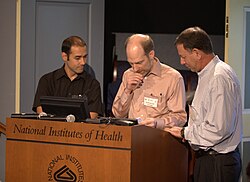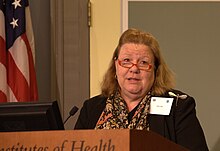Wikipedia:Wikipedia Signpost/2009-07-27/Wikipedia Academy
Volunteers lead Wikipedia Academy at National Institutes of Health
On July 16, 2009, the first Wikipedia Academy in the United States was held at the National Institutes of Health (NIH) headquarters in Bethesda, Maryland. The aim of the academy was not only to teach NIH employees and scientists about the value of contributing to Wikipedia but also how to do so, with the ultimate aim of making “health and science information more accessible and reliable”.[VolLeadWS27Jul2009 1] In order to achieve this, the organizers spent several months designing presentations specifically for the NIH. For example, they researched the structure of the organization and sent out surveys to the participants in order to learn what their perceptions of Wikipedia were.

The event, which ran from 9 am to 4 pm, consisted of three morning lectures and three simultaneous afternoon workshops. The first lecture, by Tim Vickers, argued that it is important for individuals from the NIH to contribute to Wikipedia because an increasing number of people are turning to the Internet and specifically Wikipedia for health information. He also pointed to Wikipedia's unique ability to update rapidly, focusing on the H1N1 swine flu virus and 2009 flu pandemic articles. The second lecture, by Bill Wedemeyer, explained the structure of the typical Wikipedia article and how to edit collaboratively. He also emphasized that Wikipedia's Featured articles and Good articles in the sciences are largely accurate. Finally, John Broughton discussed some of Wikipedia's quality-control measures, such as counter-vandalism and policies like verifiability. The three afternoon workshop sessions, two of which were aimed at new users and one of which was for intermediate and advanced users, were led by Broughton, Lennart Guldbrandsson, and Adrianne Wadewitz. These were designed to teach, in a hands-on fashion, the details of editing Wikipedia. Four volunteers from the Washington, D.C. area assisted in introducing the new users to Wikipedia.
From the beginning of the event, there was a great deal of enthusiasm in the room. Attendees were generally curious and interested in understanding how Wikipedia worked. As Guldbrandsson wrote in an interview for this story, "When I got there, *they* were equally happy to see us." Not only had the NIH dedicated an entire day to this event, they had, as he pointed out "arranged for video capturing of the entire event, which they were going to closed ca[p]tion afterwards and send out among the thousands of employees." This dedication continued during the afternoon sessions. Both Guldbrandsson and Vickers commented on the palpable excitement from new users making their first edit. Vickers described it as an "outburst of excitement" and Guldbrandsson as “one of my favorite moments: When the group had clicked 'save' and I remarked that they now had made their first edit on Wikipedia, there was the usual amazement: 'Are we really editing Wikipedia live?' 'Yes, you are!'" Marin Allen, NIH Director of Public Information, reported to Wedemeyer that several participants found the workshop "inspirational, a word not often used around here".

The afternoon sessions lasted for two hours, a short time to introduce people to the basics of editing. Broughton was surprised at how few topics could effectively be covered in that time. As he explained, "That's because the participants not only have to be walked through things like creating a user page and subpage, but they also need to have explained the purpose of such things." In his opinion, introductions to editing might be better done over screencasts (perhaps created by Project Bookshelf). The two hours could then be spent showing new users around the site, explaining how to use help desks, demonstrating how to effectively navigate the site, teaching how to discuss issues on talk pages, emphasizing the importance of citations, and other elements of site culture. In fact, Wedemeyer and Wadewitz led an intermediate and advanced session during the afternoon which used a similar technique. They discussed tactics for editing controversial articles such as Legalization of marijuana and MDMA and the how to handle the potential conflict of interest employees of the NIH might have in editing NIH Institute pages. As Wedemeyer wrote, "we did the most good by listening to the participants [and] addressing their concerns".
The organizers have high hopes for the future participation of the attendees and are in communication with them now. One new user began posting suggestions to Vickers' talk page immediately after the event. Wedemeyer commented how important it was that the organizers maintain connections with the participants afterwards, to encourage the NIH to make a real commitment to Wikipedia. The organizers also look forward to more such endeavors. Broughton suggested that the "Foundation should try to do lots and lots of these. We could justifiably have an Academy at every major university and college in the world." However, as Wedemeyer emphasized in an interview for this story, it will, more than likely, be the volunteer organizers who make this happen rather than the Foundation. As he wrote, "based on the experience of this Academy, they don't seem ready to run such workshops themselves at present." He suggested that they "recruit trusted volunteers with specialized knowledge to run the workshop and provide those volunteers with 'infrastructure' support."
Notes
- ^ Press release. NIH. July 14, 2009. Retrieved July 27, 2009.


Discuss this story